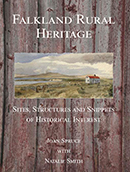KEPPEL ISLAND 51°19S, 59°58'W
Keppel lies to the north of West Falklands between Saunders and Pebble Islands and is named for Admiral Augustus Keppel. It has an area of 36.26sq km (14.00 sq miles). The highest point is Mount Keppel at 341 metres (1,119 ft). There is a wide flat valley in the centre of the island where its freshwater lakes are home for wildfowl. The north-east coast is deeply indented with sandy beaches and sand dunes. Most of the island is grass (whitegrass) heathland. There are green coastal areas in the north-east. The island supports a rich variety of Falklands wildlife and native flora.
The island became a sheep farm in 1885. Keppel was eventually sold to Dean Brothers of Pebble in 1911 who later sold it to Sam and Carol Miller and it continued as a sheep farm until 1992. Keppel was again sold to Mr Lionel Fell who cleared the sheep and today Keppel is unoccupied and a conservation area. There is a concern over the large population of Norway rats (introduced) which have led to the decline of Cobb’s Wrens and Tussac birds. The remains of the old missionary are listed buildings and some of the oldest in the islands. Measures have been taken to safeguard them.
|
|
Keppel Island Mission
Keppel is probably most notable for being the base of the South American Missionary Society for over 40 years. Yaghan Indians from neighbouring Patagonia were brought over to Keppel with the intention to instruct them in civilised life and then to return them home in the hopes that they would pass on what they had learnt to their hostile tribes. The Mission operated on Keppel between 1855 and 1898 (proposed by Captain Allen Francis Gardiner before his death in 1851). Transport between Patagonia and Keppel was made possible by their newly built 88 ton schooner Allen Gardiner. The Rev G Despard took charge of the new mission in 1856. The South American Missionary Society initially rented Keppel for £1 for one year then 160 acres were purchased and the rest of the island leased. A house for a bailiff, a chapel and dwellings were built. There was discontentment and in 1859 some families were taken back to Navarin Island where all but one of the party of men accompanying them were massacred by the Indians at Woollya. The Reverend Stirling replaced the disheartened Despard on Keppel in 1863. In 1868 the Mission was given a 60 year lease at a very favourable rent.
Yaghans were brought to ‘Cranmer Station’ where they were instructed in agricultural and gardening techniques, reading, writing and religion. Produce found a ready market in Stanley. The learning worked both ways and Thomas Bridges, a brilliant young missionary working with the Yaghans was able to compile a dictionary of their language which was to prove invaluable. A similar mission was started at Ushuaia in 1869 and the Mission tried unsuccessfully to sell Keppel. The last Fuegians were moved back to the new mission on the South American mainland in 1898. |
Can you add/ correct any information or supply photographs or information , past or present/ life/ people/ buildings? Contact: falklands.southatlantic@gmail.com
Sources include: Falkland Rural Heritage- Joan Spruce with Natalie Smith, nationalarchives.gov.fk/Jane Cameron National Archives/ Land/ buildings, The Falkland Islands- Ian J Strange, The Dictionary of Falklands Biography (including South Georgia) - Edited by David Tatham, Uttermost Parts of the Earth- E Lucas Bridges
Photographic credits: Terry Spruce, Marlane and Ali Marsh |
    
|
|
|
| |
|
|
 |
Find out more about Keppel Island |
|

